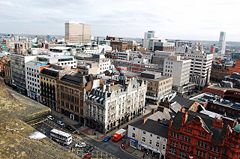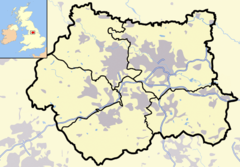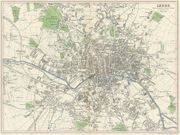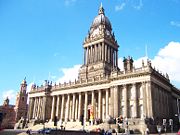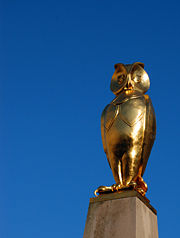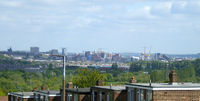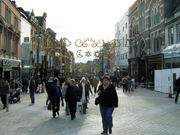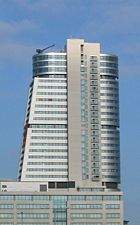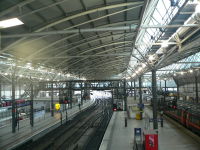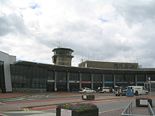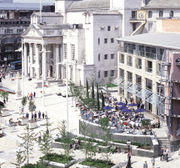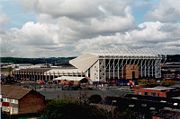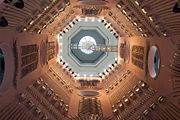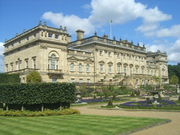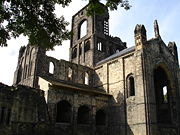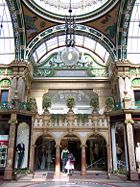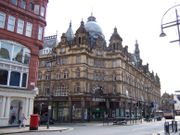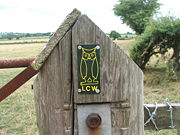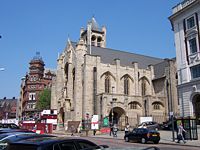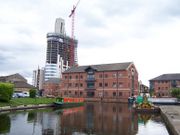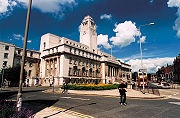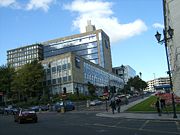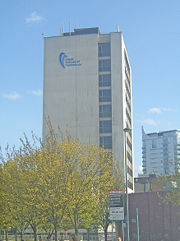Leeds
2008/9 Schools Wikipedia Selection. Related subjects: British Cities; Great Britain
| Leeds | |
|
Leeds shown within West Yorkshire |
|
| Population | 443,247 (Primary Urban Area only) |
|---|---|
| OS grid reference | |
| Metropolitan borough | City of Leeds |
| Metropolitan county | West Yorkshire |
| Region | Yorkshire and the Humber |
| Constituent country | England |
| Sovereign state | United Kingdom |
| Post town | LEEDS |
| Postcode district | LS1, LS2, LS3-LS29 |
| Dialling code | 0113 |
| Police | West Yorkshire |
| Fire | West Yorkshire |
| Ambulance | Yorkshire |
| European Parliament | Yorkshire and the Humber |
| UK Parliament | Elmet, Leeds Central, |
| Leeds E, Leeds NE, | |
| Leeds NW, Leeds W | |
| List of places: UK • England • Yorkshire | |
Coordinates:
Leeds ( pronunciation ) is a major British city located on the River Aire in West Yorkshire, England. It is the urban core and administrative centre of the wider metropolitan borough of the City of Leeds. The county borough of Leeds was awarded city status in 1893, but in 1974 this status was transferred to the larger new metropolitan borough named "City of Leeds". Thus Leeds, although commonly referred to as a "city", does not have this legal status unless the wider area is being discussed.
Historically a part of the West Riding of Yorkshire, the recorded history of Leeds can be traced to the 5th century when the Kingdom of Elmet was covered by the forest of "Loidis", the origin of the name Leeds. During the Industrial Revolution, Leeds developed into a major industrial centre for the production and trade of wool, before emerging as a centre for commerce and higher education, being the location of the University of Leeds, Leeds Trinity and All Saints and Leeds Metropolitan University. Today the city is one of the largest financial and legal centres outside London.
According to the 2001 UK census, the population of the Leeds urban area was 443,247, whereas the wider City of Leeds metropolitan district has a population of 750,200 (mid-2006 estimate) and is one of the eight largest English cities outside London that form the English Core Cities Group. It is at the centre of the West Yorkshire metropolitan county with a population of over 2.1 million.
History
The name "Leeds" came from "Loidis" (Bede states: "...regione quae vocatur Loidis" region known as Loidis), a word of Celtic origin, also surviving in the nearby place names of Ledston and Ledsham. Leeds has been known since being mentioned (as "Ledes") in the Domesday Book of 1086, (the name evolved into "Leedes" and finally "Leeds"). Leeds was an agricultural market town in the Middle Ages, and received its first charter in 1207. In the Tudor period Leeds was mainly a merchant town, manufacturing woollen cloths and trading with Europe via the Humber estuary, and the population grew from 10,000 at the end of the 17th century to 30,000 at the end of the 18th. At one point nearly half of England's total exports passed through Leeds. The Industrial Revolution resulted in the radical growth of Leeds whose population rose to over 150,000 by 1840. The city's industrial growth was catalysed by the introduction of the Aire & Calder Navigation in 1699, Leeds and Liverpool Canal in 1816 and the railway in 1848. In 1893 Leeds was granted city status. The industries that developed in the Industrial Revolution included making machinery for spinning, machine tools, steam engines and gears as well as other industries based on textiles, chemicals and leather and pottery. Coal was extracted on a large scale and the still functioning Middleton Railway, the first successful commercial steam locomotive railway in the world, transported coal from Middleton colliery into the centre of Leeds. The first permanent set of fully automatic traffic lights in the world were installed at the junction of Park Row and Bond Street, Leeds, in 1928.
By the 20th century this social and economic status started to change with the creation of the academic institutions that are known today as the University of Leeds, Leeds Metropolitan University and Leeds Trinity & All Saints. This period also witnessed expansion in medical provision particularly Leeds General Infirmary and St James's Hospital. Following World War II there was a decline in secondary industries that had thrived in the 19th century. In 1951, half the workforce was still in manufacturing; by 1971 the figure was a third. Leeds lost a third of its manufacturing jobs during 1971–1981 (Champion & Townsend, 1990, p.82). In 1991, 64,000 were employed in manufacturing. In 2003, 2,103 firms employed 44,500 (10% of workforce) - see Leeds Economy Handbook. But there are still some large engineering firms. The largest make turbine blades, components, alloys, valves and pipelines for the oil industry, switchgear, printers' supplies, copper alloys, surgical and hospital equipment, pumps, motors, radiators.
In the 1980s, the Conservative government designated Urban Development Corporations on a number of UK cities: some declining areas were taken out of local authority control and government funding was provided with the aim of speeding up and concentrating private sector investment in the most run-down areas. Leeds Development Corporation ran from 1988–1995 and helped to focus attention on two decayed industrial areas (The lower Kirkstall Valley and the riverside area to the south east of the city centre). Achievements of LDC included refurbishment of many riverside properties, the opening up of Granary Wharf and the Royal Armouries development.
Leeds is generally regarded as the dominant city of the ceremonial county of West Yorkshire, although the presence of other large cities and towns (such as Bradford and Huddersfield) means that this dominance is less pronounced than in most other English metropolitan areas. Leeds is also the largest city in Yorkshire as a whole.
Governance
Leeds is the administrative centre of the City of Leeds metropolitan borough of West Yorkshire, having previously lain within the West Riding of Yorkshire, within which it was an independent county borough from 1889 to 1974. The metropolitan borough covers a much wider area than Leeds' urban core, including once separate towns now linked to Leeds' primary urban area by urban sprawl such as Otley, Wetherby and Morley. See history and geography of the City of Leeds.
Leeds City Council governs the whole metropolitan district, and is based in Leeds Civic Hall in the city centre. It has 99 elected members, three for each of 33 wards; councillors are elected for a four year term, and one third are elected at local elections held in three years out of four. It is as of 2007 controlled by a coalition of Conservative, Liberal Democrat and Independent members. The Conservative and Liberal Democrat group leaders take the rôle of Leader of the Council for six months alternately.
Leeds is represented by six MPs, for the constituencies of Leeds Central, Elmet, Leeds E, Leeds NE, Leeds NW and Leeds W. All but the first of these constituencies also cover areas outside the city, but within the metropolitan district. Five constituencies are as of 2007 represented by Labour, and Leeds North West by a Liberal Democrat.
Leeds is within the Yorkshire and the Humber European constituency, which as of 2007 is represented by two Conservative, two Labour, one Liberal Democrat and one UKIP MEPs.
Lord Mayor of Leeds
The first mayor of Leeds, in 1662, was Thomas Danby after whom Leeds Thomas Danby college is named. A popular Victorian mayor was Henry Rowland Marsden whose statue can be seen near the university. There were 240 mayors until in 1897 Queen Victoria gave the city the privilege of having a Lord Mayor. The Lord Mayor is elected in May each year from and by the members of Leeds City Council and is the Chair of the Council.
The Lord Mayor fulfils many ceremonial duties during the year, and chooses a "Lord Mayor's charity" to support. The full title of the Lord Mayor is "The Right Worshipful the Lord Mayor of the City of Leeds". Although the Lord Mayor's remit covers the whole of the City of Leeds metropolitan district, there are also town mayors in some of the other towns in this district.
A full list of Aldermen (1626–1661), Mayors (1662–1896) and Lord Mayors (from 1897) is available on the council's website.
Geography
Areas of the city
(For places within the Leeds Metropolitan District called City of Leeds, but outside the city itself, see Leeds environs)
Until the 1974 reorganisation of local government, the County Borough of Leeds included the former parishes of Armley, Beeston, Bramley, Chapel Allerton, Farnley, Headingley/Burley, Holbeck, Hunslet, Leeds, Osmondthorpe, Potter Newton, Seacroft, Temple Newsam (covering the areas of Halton Moor, Halton, Whitkirk, Colton and Austhorpe) and Wortley. Location grid
DemographyThe city has three recognised red light districts: Spencer Place in Chapeltown, Water Lane in Holbeck and the areas surrounding the City of Mabgate public house in Mabgate, taking in Roseville Road, Telephone Street and Mushroom Street. There is a concentrated student population in Headingley and Burley Park, to the north west of Central Leeds. Moortown, Alwoodley and Adel in wealthy North Leeds have a particularly high concentration of Jewish residents. EconomyGrowth sectors in financial & business services: banking, labour recruitment*, commercial cleaning, legal services, insurance, pension funds, computing*, architecture and civil engineering, real estate, investigation & security, accountancy, equipment leasing, consultancy & market research*, advertising, and R&D*. Some of the faster growing sub-sectors during the 1990s marked *. Development
In recent times Leeds has seen many new developments, with high rise schemes making a much larger mark on Leeds' skyline. Sixteen skyscrapers are currently under construction or proposed, all of them taller than West Riding House (262 ft/80 m) - Leeds' tallest building since it was built in the 1970s. Bridgewater Place recently became the tallest building in Leeds. A taller building, the 561 ft (171 m) Lumiere building was planned be finished by 2012 but building work was stopped on 9 July 2008 owing to lack of available funds. The plan for even taller 'Kissing Towers' of Criterion Place has been scrapped for similar reasons. TourismLeeds has received several accolades in the field of tourism; including being voted by Condé Nast Traveler magazine Readers' Awards as the "UK's favourite city" in 2004, "Best English city to visit outside London" in 2005, and also "Visitor city of the year" by The Good Britain Guide in 2005. A vibrant city, rich in culture and heritage, and ideally located in the very heart of England, it is supported by an extensive rail, road and air network which makes travelling to Leeds quick and easy. Situated close to the UK's geographical centre, it benefits from good transport connections with the M1 running from Leeds to London, the M62 connecting Leeds with Manchester and the seaport cities of Hull and Liverpool, and the A1(M) for linking to the north. Leeds Bradford International Airport is one of the fastest growing regional UK airports, with a 75 per cent growth in passenger numbers in the last five years. Over 450 weekly flights connect the city to over 50 major European business and holiday destinations. Tourism in Leeds is estimated to support over 20,000 full time equivalent jobs, and on average Leeds attracts around 1.4 million people annually who stay overnight, plus a further 18.4 million who visit on day trips. Visitors to the city bring in nearly £735 m into the local economy each year and Leeds' vibrant and cultural scenes are some of the key reasons that visitors from across the UK and Europe come to Leeds. Major national and regional attractions include the Royal Armouries, Leeds Art Gallery, the Henry Moore Sculpture Centre and the West Yorkshire Playhouse. Leeds is also the only city outside London to have both its own opera and ballet companies – the internationally acclaimed Opera North and Northern Ballet Theatre. TransportRailThe rail network is still of great importance. Leeds railway station at New Station Street is one of the busiest in England outside London,with over 900 trains and 50,000 passengers per day. It provides connections to London, Southampton and the south, Birmingham and the Midlands, Kingston upon Hull and Scarborough on the East Coast, Bristol and the West Country, Newcastle, Edinburgh and the north east, Manchester and Liverpool and the north west, as well as to local and regional destinations. The station itself has 17 platforms, making it the largest in England outside London. From Leeds railway station MetroTrains operated by Northern Rail operate to all parts of West Yorkshire and surrounding local and commuter locations and other operators including National Express East Coast, CrossCountry, East Midlands Trains and TransPennine Express operate services to the rest of the country. Leeds has two railway lines offering direct services to London. The principal route is along the East Coast Main Line, with trains departing for the capital on an hourly basis throughout the day. East Midlands Trains offers an alternative route via Leicester along the Midland Main Line to London St Pancras International, home of Eurostar international services. The East Midlands Trains service operates principally because the train operators fleet of diesel high speed trains (HST's) is based at Neville Hill maintenance depot in Leeds. There are three trains per day in each direction. Tram plansThe city had plans in the 1990s and 2000s for a tram network known as Supertram. However the government axed the scheme due to an unwillingness to pay for any costs over budget, and the Department for Transport's apparent preference for a bus-based rapid transport scheme rather than a tram-based scheme. A sub-surface tramway system which could double as a public air-raid shelter facility was proposed in the 1930s by Leeds City Council, with Central Government funding. The plans were axed as the Second World War commenced and funds were diverted to the war effort. Leeds remains the largest city in Europe without a mass transit system. RoadsLeeds is the focus of the A58, A61, A62, A63, A64, A65 and A660 roads, and was promoted as Motorway City of the Seventies by Leeds City Council. Nowadays, with the M1 and M62 intersecting just to its south and the A1(M) passing just to its east, it is one of the principal hubs of the northern motorway network. There is an Inner Ring Road with part motorway status and an Outer Ring Road. The city centre is pedestrianised, and is encircled by the clockwise-only 'loop road'. Recent developments to East Leeds have seen phase 7 of the M621 which involves completion of the Outer Ring Road scheme and construction of a bridge running from the A64 near South Accommodation Road, straight to the M621. This new road link will help in taking a percentage of traffic away from the city centre and roads exiting to South Leeds and the motorways. Another project which will begin construction in late 2008 is the long awaited extension of Junction 45 on the M1. Provisions including slip roads, markings and roundabouts were all placed during construction of the motorway due to future expansion being a possibility. Now, a dual carriageway is being created from Junction 45 straight in to Leeds via Hunslet and Cross Green. This is all part of Leeds City Council's aim to re-develop and encourage investment in to the East Leeds area which in comparison to the North, South, West and Centre of Leeds, is the most underdeveloped. Leeds City council is supporting the carsharing club WhizzGo in a battle to reduce congestion and carbon emissions in the city centre and surroundings. The scheme offers local residents and businesses to save money by not having to own cars yet having access to a fleet of low-emission vehicles whenever they need. As a result, car club members tend to drive less and swap car journeys for walking, cycling or public transport. Over 30 cars are sited across the city and available to members for hire by the hour. Access to cars is by using a smart card and PIN. Bus/coachOn 30 January 2006, a zero-fare bus service (the FreeCityBus) started running, on a circular route (including stops at the bus and railway stations), in the centre of Leeds. Leeds has a large modern bus station at Dyer Street served by National Express and local bus services. Buses in the city are mainly provided by FirstBus and Arriva. Harrogate & District provides a service to Harrogate and Ripon. The Yorkshire Coastliner service runs from Leeds to Malton, Scarborough, Filey, Whitby and Bridlington via Tadcaster, York and Malton. Trolleybus plansA business case for a new trolleybus system in the Leeds region is scheduled to be submitted to the Department for Transport towards the end of 2007. This system would broadly follow the route of the axed Supertram project. Local public transport informationLeeds Travel Info is Leeds City Council's public access website providing real-time travel information in the Leeds area. West Yorkshire Metro provides bus and train information on its website, and offers the innovative "My Next Bus" service of real-time bus information by text message or online. This real-time information is also displayed in certain bus shelters. Air transportLeeds Bradford International Airport is located near Yeadon, to the north-west of the city and has both charter and scheduled flights to destinations within Europe plus Egypt and Turkey. There are connections to the rest of the world via London Heathrow Airport, Paris Charles de Gaulle Airport and Amsterdam Schiphol Airport. In 2007 Bridgepoint Capital acquired the airport from the local councils which had previously owned it, for £145.5 million. The new owners have said they are to implement a £70 million capital expenditure plan, to focus on improving passenger and retail infrastructure. They also aim to more than double passenger numbers to 7 million per annum and to add up to 20 new scheduled destinations, both by 2015. There is a direct rail service from Leeds to Manchester Airport, with trains running throughout the night. Robin Hood Airport Doncaster Sheffield is 40 miles (65 km) south of Leeds. Sea transportLeeds has good connections by road, rail and coach to Hull, only an hour away, from where it is possible to travel to Rotterdam and Zeebrugge by ferry services run by P&O Ferries. Events
SportThe city has a strong sporting heritage, with teams representing all the major national sports. Yorkshire County Cricket Club, Leeds Rhinos Rugby League Football Club and Leeds Carnegie Rugby Union Football Club all play at Headingley, where there are adjacent cricket and rugby stadia, and Hunslet Hawks RLFC are based at the John Charles Centre for Sport. Leeds United A.F.C., the city's main football team, play at Elland Road in Beeston Also, one of Leeds' most historic and influential Rugby League team the Bramley RLFC play in Leeds from the Arthur Miller Stadium (Stanningley SARLC). FootballUnlike many other large British cities, Leeds only has one league football team. Leeds United were formed in 1919 in Salem Chapel, just south of Leeds bridge, following the bankruptcy of their predecessors, Leeds City. Under the management of Don Revie, they were a major force in English football during the late 1960s and early 1970s, winning the league championship three times, the FA Cup once, the League Cup once and the Fairs Cup twice. After Revie's departure for the England job in 1974, Leeds went into decline and did not win another major trophy until 1992, when Howard Wilkinson guided them to glory in the last-ever First Division championship before the creation of the Premier League. They remained at this level for 12 years before a financial crisis contributed towards their relegation in 2004. Three years later they were relegated again, into the third tier of the English league for the first time in their history. Rugby league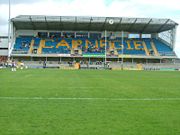
The new Carnegie Stand at Headingley. Rugby league is Leeds' second most popular spectator sport.
Leeds Rhinos are currently the best rugby league team in Leeds. They play their home games at the Headingley Stadium and compete in the Super League. They make up the top 3 sides in the league, based on the number of Challenge Cups won, together with the Bradford Bulls and St Helens RFC. In 2007 they finished 2nd in the league but they beat St Helens in the Super League Grand Final, making them Super League champions. They went on to beat the Australian NRL champions Melbourne Storm 11–4 at Elland Road on February 29 in the 2008 World Club Challenge. They are the best supported rugby team of either code throughout the UK, having won a number of domestic and international trophies, including 5 Championships, 11 Challenge Cups and 2 World Club Challenge titles. Another rugby league team from the city are the Hunslet Hawks, who are based in Hunslet, South Leeds. They play in the National League Two and their home is the John Charles Centre for Sport, formerly known as the South Leeds Stadium. Their nickname is The Parksiders, after their former home ground, Parkside. They have won the League Championship and the Challenge Cup twice each, though these honours were all achieved before the Second World War. Bramley Buffaloes, from Bramley, West Leeds, currently play in the Rugby League Conference. They are known as The Villagers and the club play their home games at Stanningley ARLFC. Leeds Akkies are also in the Conference and are based in Bramhope, North Leeds. The club was founded in 2003 by students from the three universities of Leeds, to provide a pathway from student rugby league to open age amateur rugby league. Rugby unionLeeds Carnegie, formerly known as Leeds Tykes, are the main rugby union football club in Leeds. They are owned by the same company that run the Leeds Rhinos rugby league team and, consequently, they also play at the Headingley Carnegie Stadium. Their name was changed on May 14, 2007, when it was announced that Leeds Metropolitan University would buy a 51% stake in the club and change the name to fit with the university's sport department, Carnegie College.They currently play in the Guinness Premiership, the highest level of domestic rugby union in England, having been promoted as champions of National Division One in the 2006–07 season. The club won their first trophy in 2005, with a battling performance to defeat favourites Bath in the Powergen Cup final. Otley R.U.F.C., who play at Cross Green, are another rugby union club from the area. They are based in Otley and compete in National Division Two, having been relegated from National Division One in the 2006–07 season. Morley R.F.C., located in Morley, south-west Leeds, currently play in the National Division Three North. Their nickname is The Maroons, after the colour of their kit. AthleticsLeeds City AC is amongst the biggest and most successful athletics clubs in the north of England and competes in the British Athletics League. The club has also had the most successful men's harriers section in the country in the 21st century. Since the turn of the millennium the team has never been out of the top 4 in the National Cross Country Championships, winning in 2003, 2006, 2007 and 2008. In 2006, 2007 and 2008 the team achieved the 'Grand Slam' of wins - Yorkshire, North of England and English National Champions. They were also 2007 National 12-stage road relay champions and gained silver medals in the National 6-stage and cross country relays the same year. Many athletic clubs serve the youth of the city and enter teams in the country's major running events - especially raising funds for local charities in the London Marathon and the British 10K. Leeds hosts many athletics events itself, most notably the Help the Aged Abbey Dash 10K, the Jane Tomlinson 10K and the Leeds Half Marathon. Women's footballLeeds Carnegie L.F.C. are the best-placed women's football team in Leeds. They currently compete at the highest level in England, the FA Women's Premier League National Division, for the 2007–08 season, having finished 5th in the league last season. The club currently play their home matches at The Park, home of Tadcaster Albion A.F.C., in Tadcaster, North Yorkshire. Another women's team based in Leeds is Leeds City Vixens L.F.C.. They currently play in the Northern Combination Women's Football League, which is the third tier of women's football. Last season they finished 2nd in the league, narrowly missing out on promotion into the FA Women's Premier League Northern Division. Presently, the club play their home fixtures at The Bracken Edge, home of Yorkshire Amateur A.F.C.. Other SportsThe "LeedsLeedsLeeds" Ultimate (frisbee) team competes nationally and internationally. Speedway racing was staged in Leeds in the period 1928 to 1939. The track was at the greyhound stadium in Elland Road. The track entered a team in the 1931 Northern league. The universities offer many tens of sports, including American football and ultimate (frisbee). Sports facilitiesLeeds has a wealth of sports facilities including the 40,000 capacity Elland Road football stadium, a host stadium during the 1996 European Football Championship; the Headingley Carnegie Stadiums, world famous for both cricket and rugby league; John Charles Centre for Sport with an Olympic sized pool in its Aquatics Centre and a stadium used for rugby league (Hunslet RLFC), athletics, bowls, football and tennis. Other facilities include the Leeds Wall (climbing), Yeadon Tarn sailing centre. Nearby, in Castleford, is Xscape (real snow indoor ski and snowboard slope with ice climbing wall). The Aquatics Centre at the John Charles Centre for Sport, replaces facilities at the Leeds International Swimming Pool Culture and recreationMuseums and the artsA new Leeds City Museum is expected to open in August 2008 in the building of the former Mechanics Institute, more recently used as the Civic Theatre, in Millennium Square. The previous city museum was in the Central Library building, and closed some years ago. Abbey House Museum is housed in the former gatehouse of Kirkstall Abbey, and includes walk-through Victorian streets and galleries describing the history of the abbey, childhood, and Victorian Leeds. Armley Mills Industrial Museum is housed in what was once the world's largest woollen mill, and includes industrial machinery and railway locomotives. Thwaite Mill Museum is a fully-restored water-powered mill on the river Aire to the east of the city centre. A fulling mill was built on the site in 1641, and it was extensively rebuilt in 1823–25. The Thackray Museum is a museum of the history of medicine, featuring topics such as Victorian public health, pre-anaesthesia surgery, and safety in childbirth. It is housed in a former workhouse next to St James's hospital. The Royal Armouries Museum opened in 1996 in a dramatic modern building when this part of the collection was transferred from the Tower of London. Leeds Art Gallery reopened in June 2007 after a major renovation project, and houses important collections of traditional and contemporary British art. Contemporary Art venues include Gallery 42, Leeds Met Gallery, PS:L and theartmarket. Leeds has the Grand Theatre (where Opera North is based), the City Varieties Music Hall (which has hosted performances by Charlie Chaplin and Harry Houdini plus being the venue of TV's "The Good Old Days") and the West Yorkshire Playhouse. The Leeds Festival takes place every year in Bramham Park, having moved from Temple Newsam after pressure from some local residents. It features some of the biggest names in rock and indie music. The city is home to the Leeds International Pianoforte Competition, held every three years since 1963, which has launched the careers of many major concert pianists. There is also the Leeds International Concert Season the largest local authority music programme of any UK city outside London. The city also has an internationally recognised film festival; the Leeds International Film Festival is the largest film festival in England outside London and shows films from around the world. It incorporates the highly successful Leeds Young People's Film Festival, which features exciting and innovative films made both for and by children and young people. Some of the first moving pictures in the world were taken in the city, by Louis Le Prince, of a Roundhay Garden Scene and of Leeds Bridge in 1888. Leeds also has a very important dance community; it currently is the home of the world-renowned dance companies the Northern Ballet Theatre and Phoenix Dance. Historic houses and parksThe ruins of Kirkstall Abbey, a Cistercian abbey dating from the 12th century, are in an open park alongside the river Aire in Kirkstall, to the west of the city centre. The abbey gatehouse houses the Abbey House Museum. To the east of the city centre, Temple Newsam house dates from the early 16th century and has an extensive estate including gardens and a rare breeds farm. The house was left to Leeds City Council following the occupiers death in 1922. The house is notable Jacobean architecture. Lotherton Hall, with art collections and a bird garden, lies to the east of the city, Bramham Park to the north-east (this now hosts the Leeds Carling Weekend (Leeds Festival) since it was moved from Temple Newsam due to riots and trouble in the surrounding estates), and Harewood House to the north. Kirkstall Abbey, Temple Newsam, and Lotherton Hall are owned and administered by Leeds City Council. To the north lies Roundhay Park with its well regarded Tropical World hothouse. Other parks in the city include Golden Acre Park which lies between Adel and Bramhope, Hall Park in Horsforth, Woodhouse Moor in Hyde Park, Potternewton Park between Chapeltown and Harehills, Temple Newsam Park stretching from Halton Moor to Colton, East End Park in the location of the same name, Cross Flatts Park in Beeston and Middleton Park in Middleton. The parks of the city are put to good use. Roundhay Park hosts numerous concerts, as does Bramham Park (near Wetherby) and Temple Newsam. Roundhay Park is probably the most notable of the parks in Leeds and certainly the largest (in excess of 700 acres/2.8 square kilometres). It is one of the largest inner city parks in Europe and visited by almost one million people every year. The car park at Roundhay Park is notable as it contains the only remaining trolley poles from the former tram system in the city. The arena area of Roundhay Park is used for concerts and over the years had seen concerts from The Rolling Stones, Michael Jackson, Simple Minds, Madonna, Genesis, Robbie Williams and U2. ShoppingLeeds has an extensive and diverse range of shops and department stores, and has been described by the Lonely Planet guides as the ' Knightsbridge of the North.' The diverse range of shopping facilities, from individual one-off boutiques to large department stores, which notably include Harvey Nichols and Louis Vuitton outlets, has greatly expanded the Leeds retail base. The Victoria Quarter, several existing arcades connected together by roofing the entirety of Queen Victoria Street with stained glass, is located off Briggate, Leeds' main shopping street. Other popular shopping attractions include Leeds Kirkgate Market, Granary Wharf, Leeds Shopping Plaza, Headrow Shopping Centre, The Light, The St John's Centre, The Merrion Centre Leeds, Crown Point, Birstall Retail Park and the White Rose Centre. In addition, there are also two proposed shopping developments, namely the Eastgate Quarters and Trinity Quarter. 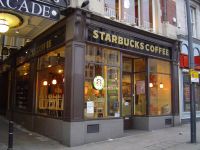
A Starbucks coffee shop in Leeds, United Kingdom
Music
Leeds has produced many notable acts, some recent examples being the Kaiser Chiefs, The Music, the Pigeon Detectives, Corinne Bailey Rae, and Your Vegas. Other acts from Leeds include The Wedding Present - who once had 12 new hit singles in the same calendar year, a feat unmatched by any other artist - Chumbawamba, The Sisters of Mercy and Melanie B, of the Spice Girls. The punk band Gang of Four and Grindie band Hadouken! both formed after meeting at Leeds University.Leeds is also known for it's early 90's indie scene,with such bands as. Edsel Auctioneer, Cud, Greenhouse, Pale Saints and Bridewell Taxis and many others.
House Music had a big impact on Leeds when it arrived in the late 1980s. Early house nights included Downbeat at the Warehouse, Meltdown at the Astoria in Harehills, and Joy and Kaos at various temporary venues, along with a thriving Shebeen or "Blues" scene in Chapeltown. Along with Sheffield and Bradford, Leeds was a centre for the Yorkshire Bleeps and Bass scene in 1989–1990, with influential local bands such as LFO, Nightmares on Wax, Ital Rockers, Unit 93 and Juno on Sheffield's Warp Records and Leeds' Bassic Records. The earlier underground house scene developed into the Leeds club scene of the 1990s, when for a while Leeds held the title of Britain's clubbing capital. Both Back to Basics and mixed gay night Vague enjoyed the title of best club in Britain at different points in the decade, whilst The Orbit in Morley was an internationally recognised techno mecca (Orbit closed in the late 1990s and was replaced by a restaurant).
Leeds initially played host to the northern leg of the V Festival between 1996 and 1998 before the event moved to Weston Park, Staffordshire. In 2000, Leeds played host to the first and as of 2006 the only ever BBC Radio 1 Love Parade at Roundhay Park. Since 1999 the Leeds Festival, a northern leg of the well established Reading Festival, has taken place on August bank holiday weekend. The event was initially held at Temple Newsam (the venue for the Leeds V Festival) before protests from residents forced a move to Bramham Park. Leeds is also home to the Leeds International Pianoforte Competition which is regarded highly. It was established in 1963 by Fanny Waterman and Marion Stein with the 15th competition in September 2006. West Yorkshire Playhouse and the neighbouring Venue at Leeds College of Music play host to the biennial FuseLeeds Festival showcasing an eclectic mix of more left-field music. The two-day O2 Wireless Festival took place at Harewood House between 2006 and 2007.
Leeds plays host to many venues, currently including Leeds University refectory (where The Who recorded their 1970 live album Live at Leeds and Motörhead partially recorded their most successful album No Sleep Til Hammersmith), The Cockpit, Brudenell Social Club, The Faversham, The Hi-Fi club, The Wardrobe, The Irish Centre, Joseph's Well, The New Roscoe and Trash (formally The Mixing Tin) among others. Occasional music events are held in Millennium Square in the city centre (including the Kaiser Chiefs and Fall Out Boy in 2006), Roundhay Park (which was home to Love Parade in 2000 and has hosted gigs by the likes of Robbie Williams, U2, Michael Jackson and The Rolling Stones), Harewood House (which has hosted gigs by the likes of James Blunt and The Who, as well as popular classical concerts), Leeds Town Hall (which hosted the Kaiser Chiefs, Morrissey and is the main venue for the Leeds International Concert Season), The Venue at Leeds College of Music, and Leeds Parish Church (which has a full programme of musical events, many associated with its Choral Foundation). On 25 May 2008, the local band Kaiser Chiefs played a sell-out 30,000 capacity gig at Elland Road, following in the footsteps of Queen, U2 and Happy Mondays who have also played there. Recently attempts have been made to build an arena in the city (currently larger touring acts tend to play either Manchester or Sheffield owing to the relatively small capacity of the refectory, Leeds's biggest permanent venue). In the next year the club previously known as Creation will be developed into a Carling Academy, and will have a bigger capacity than any other venue in the city. NightlifeLeeds has a very large student population, resulting in a large number of pubs, bars, nightclubs and restaurants, as well as a multitude of venues for live music such as The Cockpit, New Roscoe, Joseph's Well, The Brudenell Social Club, The Faversham and The Wardrobe, which combine to generate a vibrant and nationally renowned nightlife. Leeds includes the original home of the pioneering club nights Back 2 Basics and Speedqueen. Also, until a few years ago, nearby Morley, was home to the legendary Orbit, which for 13 years was known internationally as one of the original and best techno clubs in the country. Leeds is home to a number of large 'super-clubs' including Oceana (Leeds), Discotheque by Gatecrasher, and Club Mission, but also a strong selection of independent clubs such as Hi-Fi, Space, Mint and The West Indian Centre, which hosts the now legendary 'Sub Dub' nights. The full range of music tastes is catered for throughout the city. Leeds also has a well established gay nightlife scene. The Bridge Inn and The New Penny, both on Call Lane, have long been gay night spots. Queen's Court offers a similar experience to its London counterpart Rupert Street. Other more recent additions such as Bar Fibre, on Lower Briggate and Mission offer more contemporary 'straight friendly' environments, along with The Viaduct and Blades just across the road. During the summer months the secluded courtyard that lies between Bar Fibre and Queens Court transforms into a lively a beer garden. The refurbished Warehouse venue is now also home of the alternate Saturday club nights Technique/Asylum. Towards Millennium Square and the Civic or Northern Quarter, is a growing entertainment district thriving on both students and weekend visitors. Millennium Square has many bars (including amongst others popular chains Jongleurs, Tiger Tiger, Revolution and Ha!Ha!), various upmarket restaurants and large outdoor screen mounted on the side of the Civic Theatre. Millennium Square also plays host to many large seasonal events such as Earth From The Air, IceCube (Europe’s largest outdoor ice rink), Christmas markets, Gigs and Concerts, citywide parties and the world famous Rhythms of the City Festival. Millennium Square is adjacent to the Mandela Gardens, which were opened by Nelson Mandela in 2001. A number of public art features, fountains, a canal and greenery can be found here as an oasis amongst the city centre excitement. Leeds is also home to some Bohemian bars that are not aimed at the 'usual' weekend crowd - especially the bars in and around Briggate and North Street North Bar, Sandanista, Mojo, The Reliance (Reli), Reform, etc), Baby Jupiter on York Place and Milo on Call Lane. WalkingThe Leeds Country Way is a waymarked circular walk of 62 miles (99 km) through the rural outskirts of the city, never more than 7 miles (11 km) from City Square. The Meanwood Valley Trail leads from Woodhouse Moor along Meanwood Beck to Golden Acre Park. The Leeds extension of the Dales Way follows the Meanwood Valley Trail before it branches off to head towards Ilkley and Windermere. Leeds is on the northern section of the Trans Pennine Trail for walkers and cyclists, and the towpath of the Leeds and Liverpool Canal is another popular walking route. In addition, there are many parks and public footpaths in both the urban and rural parts of Leeds, and the Ramblers Association, YHA and other walking organisations offer sociable walks. The Ramblers Association publish various booklets of walks in and around Leeds. ReligionThe majority of people in Leeds identify themselves as Christian. Fairly unusually for a settlement of its size, Leeds does not have a Church of England Cathedral, this is because Leeds is part of the Anglican Diocese of Ripon and Leeds with the Cathedral for this Diocese being in Ripon. However, Leeds does have a Roman Catholic Cathedral, being the Episcopal seat of the Roman Catholic Diocese of Leeds. Many other Christian denominations are established in Leeds, including Assembly of God, Baptist, Christian Scientist, Church of Jesus Christ of Latter-day Saints ("Mormons"), Community of Christ, Greek Orthodox, Jehovah's Witnesses, Jesus Army, Lutheran, Methodist, Nazarene, Newfrontiers network, Pentecostal, Salvation Army, Seventh-Day Adventist, Society of Friends ("Quakers"), Unitarian, United Reformed, Vineyard, Wesleyan Church, an ecumenical Chinese church, and several independent churches. The proportion of Muslims in Leeds is average for the country. Mosques can be found throughout the city, serving Muslim communities in Harehills, Hyde Park and parts of Beeston. The largest mosque is Leeds Grand Mosque in Hyde Park. The Sikh community is represented by Gurdwaras (Temples) spread across the city. There is also a colourful religious annual procession, called the Nagar Kirtan, into Millennium Square in the city centre around 13/14 April to celebrate Baisakhi -- the Sikh New Year and the birth of the religion. It is estimated around 3,000 Sikhs in Leeds take part in this annual event. Leeds has the third-largest Jewish community in the United Kingdom, after those of London and Manchester. The areas of Alwoodley and Moortown contain sizeable Jewish populations. There are eight active synagogues in Leeds. The small Hindu community in Leeds have a Hindu temple (mandir) at Hyde Park. The temple has all the major Hindu deities and is also dedicated to the Lord Mahavira of the Jains . Various Buddhist traditions are represented in Leeds, including: FWBO, Soka Gakkai, Theravada, Tibetan and Zen. The Buddhist community ( sangha) comes together to celebrate the major festival of Wesak in May. Public servicesWater supply and sewerage in Leeds is provided by Yorkshire Water, part of the Kelda Group. Prior to 1973 it had been provided by the Leeds Corporation. Policing in Leeds is by the West Yorkshire Police. The force has eight divisions, three of which cover Leeds: AA "North West Leeds Division" covering north and west Leeds with a station at Weetwood; BA "North East Leeds Division", covering north east Leeds with stations at Stainbeck near Chapel Allerton and Killingbeck; CA "City and Holbeck Division" covering central and south Leeds with stations at Millgarth (City Centre) and Holbeck. Fire and rescue services are provided by the West Yorkshire Fire and Rescue Service. The fire stations in Leeds are: Cookridge, Gipton, Hunslet, "Leeds" (near city centre, on Kirkstall Road) and Moortown. Health services are provided by the Leeds Teaching Hospitals NHS Trust, Leeds Primary Care Trust and Leeds Partnerships NHS Foundation Trust which provides mental health services. Leeds General Infirmary is a listed building with more recent additions and is in the city centre. St James's University Hospital, Leeds, known as "Jimmy's", is to the north east of the city centre and is one of the largest teaching hospitals in Europe. Other hospitals are Chapel Allerton Hospital, Seacroft Hospital, and Leeds Dental Institute. The "Pan Leeds Health Portal" provides information on all NHS services in Leeds. Notable peopleAn inhabitant of Leeds is locally known as a Loiner, a word of uncertain origin, possibly from Loidis, an early name for the region mentioned around 700AD by Bede. The term is rarely used or understood. The mock-classical adjectives Leodensian and Leodiensian are sometimes used by some local sports clubs, and the word Leodensian also features in the lyrics of " I Predict a Riot" by Kaiser Chiefs, although in that context it was referring to John Smeaton, a famous 18th century resident of the city (who resided in Austhorpe Lodge, now the site of Austhorpe Primary School) as a founder of Leeds Grammar School, as a Leeds Grammar School leaver is called an Old Leodensian. Notable people born in and around the Leeds area include:
EducationLeeds has a very large number of primary schools, secondary schools, special schools and further and higher education establishments, with Education Leeds having responsibility for statutory education for young people in the city. There is a partial list of state and independent schools, colleges and universities in Leeds. However, because like most UK cities, Leeds has a falling birth rate, the council have come under pressure in recent years to reduce the number of schools, merging Matthew Murray School and Merlyn Rees School as well as closing Braim Wood School. Primary schools have also been hit. In 2006, Headingley Primary School was closed and a religious primary school 'secularised' to take over from Headingley. Leeds has two universities, the University of Leeds, with around 31,500 full-time students (and a further 52,000 on short courses), and Leeds Metropolitan University with around 26,000 (according to UCAS; the LMU website claims 37,000). It also has several higher education colleges: Leeds College of Art and Design (formerly Jacob Kramer College), Leeds Trinity & All Saints, Leeds College of Music (the largest music college in the UK), and Park Lane College Leeds (which offers both further and higher education). This gives Leeds one of the largest student populations in the country. Indeed recently it has gained accolades as the Best UK University Destination in The Independent newspaper. Leeds Trinity & All Saints is applying to become an independent University, by the name 'Leeds Trinity'. The city is home to several further education colleges, such as Park Lane College Leeds (the largest further education college in Leeds with over 38,500 students), Leeds College of Technology, Leeds College of Building, Joseph Priestley College and Leeds Thomas Danby. Notre Dame Catholic Sixth Form College is a very large college for A-level students close to the city centre. The city's state schools trace their history to the Elementary Education Act 1870 and the formation of the Leeds School Board in 1871. Under the Government's targets for better schools for children, many schools are being rebuilt or undergoing refurbishment. The city's oldest and largest private school is The Grammar School at Leeds, which was legally created in 2005 following the merger of Leeds Grammar School and Leeds Girls' High School. Both schools had long histories, dating back to 1552 and 1857 respectively. There are several other private schools. OFSTED reports are available for all schools and further education colleges in Leeds. Twin townsTown twinning, or "sister cities", takes place at the level of local authority. The City of Leeds metropolitan district has several twinning or partnership arrangements:
The city also has "strong contacts" with the following cities "for the purposes of ongoing projects": |
|||||||||||||||||||||||||||
